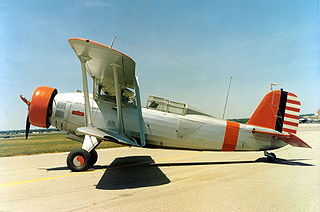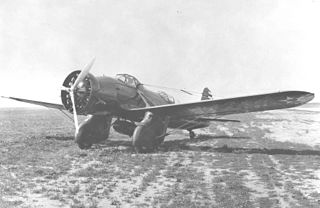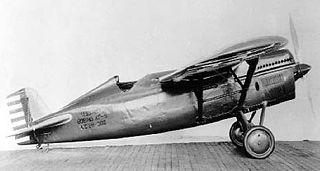
The Douglas O-38 was an observation airplane used by the United States Army Air Corps.

The North American O-47 is an American observation fixed-wing aircraft monoplane designed in the mid-1930s and used by the United States Army Air Corps during the Second World War. It has a low-wing configuration, retractable landing gear, and a three-blade propeller.

The Curtiss YA-10 Shrike was a 1930s United States test and development version of the A-8 Shrike ground-attack aircraft using various radial engines in place of the inline Vee.

The Curtiss XA-14 was a 1930s United States airplane, the first multi-engine attack aircraft tested by the United States Army Air Corps. Carrying a crew of two, it was as fast as the standard pursuit aircraft in service at the time.

The Curtiss A-18Model 76A Shrike II was a 1930s United States twin-engine ground-attack aircraft. It was the production test version of that company's A-14 Shrike.

The Boeing XP-9 was the first monoplane fighter aircraft produced by the United States aircraft manufacturing company Boeing. It incorporated sophisticated structural refinements that were influential in later Boeing designs. The sole prototype exhibited unsatisfactory characteristics with its lack of pilot visibility directly leading to its cancellation.

The Boeing F3B was a biplane fighter and fighter bomber that served with the United States Navy from 1928 into the early 1930s.

The Curtiss F7C Seahawk was a carrier-capable biplane fighter aircraft of the United States Navy Marine Corps in the late 1920s and early 1930s.

The Vought O2U Corsair was a 1920s biplane scout and observation aircraft. Developed by Vought Corporation, the O2U was ordered by the United States Navy (USN) in 1927. Powered by a 400 hp (298 kW) Pratt & Whitney R-1340 engine, it incorporated a steel-tube fuselage structure and a wood wing structure with fabric covering. Many were seaplanes or amphibians.

The Heinkel He 50 was a German World War II-era dive bomber, originally designed for the Imperial Japanese Navy. Serving in Luftwaffe prewar dive-bombing units, the He 50 served until almost the end of World War II as a night harassment bomber.

The Heinkel He 72 Kadett ("Cadet") was a German single-engine biplane trainer of the 1930s.

The Aeronca L-16 was a United States Army liaison aircraft built by Aeronca. It saw extensive service during the Korean War. It was essentially a militarized version of the Aeronca Champion. From 1955 large numbers were transferred to the Civil Air Patrol.

The Douglas O-43 was a monoplane observation aircraft used by the United States Army Air Corps.

The Consolidated PT-1 Trusty was a biplane primary trainer used by the United States Army Air Service (USAAS).

The Curtiss BF2C Goshawk was a United States 1930s naval biplane aircraft that saw limited success and was part of a long line of Hawk Series airplanes made by the Curtiss Aeroplane and Motor Company for the American military, and for export as the Model 68 Hawk III.

The Consolidated O-17 Courier was an observation and training aircraft used by the United States National Guard.

The Consolidated Model 2 was a training airplane used by the United States Army Air Corps, under the designation PT-3 and the United States Navy under the designation NY-1.

The Fairchild AT-21 was an American World War II specialized bomber crew trainer, intended to train crews in the use of power gun turrets or a gun on a flexible mount, as well as learn to function as a member of a crew. It had a brief career as a training aircraft before modified bombers took over this role.

The Consolidated P2Y was an American flying boat maritime patrol aircraft. The plane was a parasol monoplane with a fabric-covered wing and aluminum hull.

The Northrop Beta was an American single-engine, all-metal, low-wing sporting monoplane built in 1931.





















